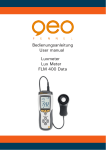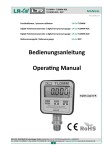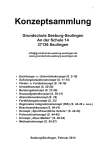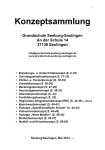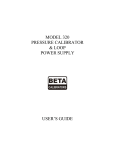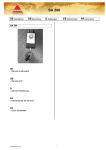Download Bedienungsanleitung User manual Gasdetektor Gas - geo
Transcript
Bedienungsanleitung User manual Gasdetektor Gas detector FGD 1 LIEFERUMFANG Gasdetektor FGD 1, Batterie, Tragetasche, Bedienungsanleitung WARN- UND SICHERHEITSHINWEISE Richten Sie sich nach den Anweisungen der Bedienungsanleitung. Anleitung vor Benutzung des Gerätes lesen. Niemals das Gehäuse öffnen. Reparaturen nur vom autorisierten Fachhändler durchführen lassen. Keine Warn- oder Sicherheitshinweise entfernen. Gerät nicht in Kinderhände gelangen lassen. Wenn das Gerät von einer kalten in eine warme Umgebung gebracht wurde, erst warten, bis es Zimmertemperatur erreicht hat, sonst könnte das entstehende Kondenswasser das Gerät schädigen. Gerät nur in gasfreier Umgebung einschalten. Gerätefunktionen regelmäßig, z. B. mit einem Feuerzeug, überpüfen. EIGENSCHAFTEN •Visuelle Leckerkennung mit LED-Anzeige •Präzisionssenor erkennt kleinste Lecks •Schnelle Ansprechzeit innerhalb von 2 Sekunden •Eingebauter Köpfhörereingang •Mit 16“-Sonde •Empfindlichkeit: 50 ppm (Methan) / (ppm = parts per million) •Nachweis folgender Gase: Erdgase, Propan, Butan, Methan, Azeton, Alkohol, Benzin, Kerosin, Kohlenmonoxid (nicht mengenmäßig), Ammoniak, Dampf, Hydrogensulfid, Rauch, Lösungsmittel, Verdünnungsmittel, Naphta 2 BESTIMMUNGSGEMÄßE VERWENDUNG •Aufspüren von Gasen durch LED-Anzeige und akustisches Signal UMGANG UND PFLEGE •Messinstrumente generell sorgsam behandeln. •Nach Benutzung mit weichem Tuch reinigen (ggfs. Tuch in etwas Wasser tränken). •Wenn das Gerät feucht war, sorgsam trocknen. Erst in den Koffer oder die Tasche packen, wenn es absolut trocken ist. •Transport nur in Originalbehälter oder -tasche. TECHNISCHE DATEN Empfindlichkeit Sensor Aufwärmzeit Ansprechzeit Arbeitszyklus Länge der Sonde Stromversorgung Betriebsdauer Alarm Abmessungen Gewicht 50 ppm (Methan) Schwachstromhalbleiter ca. 60 Sekunden weniger als 2 Sekunden durchgängig 16“ 3 x C Alkaline 8h visueller und akustischer Alarm bei 10 % UEG* für Methan 221 x 72 x 46 mm 498 g * UEG = Untere Explosionsgrenze; Minimalkonzentration eines brennbaren Gases, bei dem es durch eine Zündquelle zu brennen beginnen kann. 3 BEDIENFELD 1)Sensor 2)Alarm-LED 3)AN/AUS-LED 4)AN/AUS-Schalter 5)Anschluss Kopfhörer 6)Regler für Empfindlichkeit 7)Griff 8)Batteriefach 9)Halterung für Schwanenhalt 10)Schwanenhals 1 2 3 10 4 5 6 9 8 7 4 BATTERIE Der Batteriewechsel ist erforderlich, wenn: •die grüne LED (Ready) nicht leuchtet; •wenn das Gerät nach dem Einschalten keine Reaktion zeigt. Zum Batteriewechsel den Batteriefachdeckel vom Griff schieben, die alten Batterien entnehmen und durch neue ersetzen; dabei auf die Polarität achten. Batteriefachdeckel wieder schließen. BEDIENUNG Beachte Das Gerät nur in gasfreier Umgebung einschalten! An frischer Luft Schalter 4 am Gerät nach rechts schieben, um das Gerät einzuschalten. Den Regler für die Empfindlichkeit auf das Minimum einstellen. Die grüne LED (Ready) beginnt zu leuchten, und der Alarmton ertönt. Nach dem ersten Einschalten an frischer Luft durchläuft das Gerät eine Aufwärm- und Kalibrierphase von ca. einer Minute. Der Alarmton zeigt in diesem Fall nicht das Vorhandensein von Gas an, sondern er gehört zur Kalibrierphase. Funktionstest Vor jedem Gebrauch sollte ein kurzer Funktionstest durchgeführt werden: Empfindlichkeit auf das Minimum einstellen und Gerät einer Gasquelle aussetzen, z. B. einem Feuerzeug. Der Alarmton sollte einsetzen. 5 Optimalbedingungen Optimale Messergebnisse werden bei folgenden Umgebungsbedingungen erzielt: Temperatur 0°C bis 50°C Luftfeuchtigkeit 10 bis 90 %RH Lecksuche Gerät einschalten und Empfindlichkeitsregler so lange von Minimum in Richtung Maximum drehen, bis ein langsamer tickender Ton einsetzt (= Justierung der Empfindlichkeit). Nun den Sensor in Richtung des möglichen Lecks bewegen. Wenn eine erhöhte Gaskonzentration vorhanden ist, erhöht sich die Frequenz des Ticktons. Die Alarm-LED beginnt zu blinken, und mit zunehmender Gaskonzentration wird der Alarmton lauter. Kopfhörer Bei starken Nebengeräuschen empfiehlt es sich, einen Kopfhörer an die entsprechende Buchse des Gerätes anzuschließen und die Alarmtöne über Kopfhörer zu verfolgen. 6 CE-KONFORMITÄT Das Gerät hat das CE-Zeichen gemäß den Normen EN 61000-6-3:2001, EN 61000-6-1:2001. ELEKTROMAGNETISCHE VERTRÄGLICHKEIT •Es kann nicht generell ausgeschlossen werden, dass das Gerät andere Geräte stört (z.B. Navigationseinrichtungen); •durch andere Geräte gestört wird (z.B. elektromagnetische Strahlung bei erhöhter Feldstärke z.B. in der unmittelbaren Nähe von Industrieanlagen oder Rundfunksendern). GARANTIE Die Garantiezeit beträgt zwei (2) Jahre, beginnend mit dem Verkaufsdatum. Die Garantie erstreckt sich nur auf Mängel wie Material- oder Herstellungsfehler, sowie die Nichterfüllung zugesicherter Eigenschaften. Ein Garantieanspruch besteht nur bei bestimmungsgemäßer Verwendung. Mechanischer Verschleiß und äußerliche Zerstörung durch Gewaltanwendung und Sturz unterliegen nicht der Garantie. Der Garantieanspruch erlischt, wenn das Gehäuse geöffnet wurde. Der Hersteller behält sich vor, im Garantiefall die schadhaften Teile instand zusetzen bzw. das Gerät gegen ein gleiches oder ähnliches (mit gleichen technischen Daten) auszutauschen. Ebenso gilt das Auslaufen der Batterie nicht als Garantiefall. 7 HAFTUNGSAUSSCHLUSS Der Benutzer dieses Produktes ist angehalten, sich exakt an die Anweisungen der Bedienungsanleitung zu halten. Alle Geräte sind vor der Auslieferung genauestens überprüft worden. Der Anwender sollte sich trotzdem vor jeder Anwendung von der Genauigkeit des Gerätes überzeugen. Der Hersteller und sein Vertreter haften nicht für fehlerhafte oder absichtlich falsche Verwendung sowie daraus eventuell resultierende Folgeschäden und entgangenen Gewinn. Der Hersteller und sein Vertreter haften nicht für Folgeschäden und entgangenen Gewinn durch Naturkatastrophen wie z.B. Erdbeben, Sturm, Flut, usw. sowie Feuer, Unfall, Eingriffe durch Dritte oder einer Verwendung außerhalb der üblichen Einsatzbereiche. Der Hersteller und sein Vertreter haften nicht für Schäden und entgangenen Gewinn durch geänderte oder verlorene Daten, Unterbrechung des Geschäftsbetriebes usw., die durch das Produkt oder die nicht möglliche Verwendung des Produktes verursacht wurden. Der Hersteller und sein Vertreter haften nicht für Schäden und entgangenen Gewinn resultierend aus einer nicht anleitungsgemäßen Bedienung. Der Hersteller und sein Vertreter haften nicht für Schäden, die durch unsachgemäße Verwendung oder in Verbindung mit Produkten anderer Hersteller verursacht wurden. 8 SUPPLIED WITH Gas detector FGD 1, battery, carrying bag, user manual SAFETY INSTRUCTIONS Follow up instructions given in operators’ manual. Carefully read user manual before starting operations. Use instrument for measuring jobs only. Do not open instrument housing. Repairs should be carried out by authorized workshops only. Please contact your local dealer. Do not remove warning labels or safety instructions. Keep instrument away from children. Always keep instrument dry. If instrument was brought from a cold to a warm area wait until it has reached ambient temperature before switching on; otherwise condensation may destroy the instrument. Switch on instrument only in an atmospere free of gas. It is recommended to check functions of the instrument regularly, i.e. with a lighter. INTENDED USE OF INSTRUMENT •Detection of gas with LED indication and acoustic signal 9 FEATURES •Visual leak detection by LED indicaton •Precision sensor detects even smallest leaks •Fast response time within 2 seconds •Includes eaphone jack •Sensitivity: 50 ppm (methane) / (ppm = parts per million) •16“ probe •Detects gas types: natural gas, propane, butane, methane, acetone, alcohol, ammonia, steam, carbon monoxide (not to quantity), gasoline, kerosene, hydrogen sulfide, smoke, industrial solvents, lacquer thinner, naphta CARE AND CLEANING •Handle measuring instruments with care. •Clean with soft cloth only after any use. If necessary damp cloth with some water. •If instrument is wet clean and dry it carefully. Pack it up only if it is perfectly dry. •Transport in original container / case only. 10 TECHNICAL DATA Sensitivity Sensor Warm-up time Response time Duty cycle Probe length Power supply Operating time Alarm Size Weight 50 ppm (methane) Low power semiconductor approx. 60 seconds less than 2 seconds continuous 16“ 3 x C alkaline 8h visible and acoustic alarm at 10 % LEL* for methane 221 x 72 x 46 mm 498 g * LEL: = Lower explosive limit; minimum concentration of a combustible gas to combust when exposed to a source of ignition. KEYPAD 1)Sensor 2)Alarm-LED 3)ON/OFF LED 4)ON/OFF button 5)Earphone jack 6)Sensititvity button 7)Handle 8)Battery case 9)Probe clip 10)Gooseneck 11 1 2 3 10 4 5 6 9 8 7 BATTERY It is necessary to replace the battery if: •the green LED (Ready) does not light •the instrument does not show any activity after switching on. To replace the battery open the battery cover, remove the old battery and replace by new ones (take care to polarity). Close battery cover again. 12 OPERATION Note Switch on detector in atmosphere free of gas only! Switch on the instrument by sliding the ON/OFF button to the right in fresh air. The sensitivity control should be set to minimum. The green LED (Ready) will light and the alarm will sound. After switching on the detector for the first time the instrument will run through a warm-up and calibration period for about 60 seconds. During this period the alarm will not show any gas leak but this sound belongs to the calibration period. Check of function Each time the detector is used you should first run a quick check of function: Turn the sensitivity button of the instrument to minimum and expose the sensor to a gas source, i. e. a lighter. Now the alarm should sound. Optimum conditions Optimum measuring results will be achieved under following conditions: Temperature 0°C up to 50°C Air humidity 10 up to 90 %RH Detection of gas leak Switch on instrument and turn the sensitivity button from minimum to maximum until a slowly ticking sound starts (adjustment of sensitivity). Now move the detecor towards the leak suspected. If the instrument detects a higher gas concentration the frequency of the alarm sound will increase. The alarm LED starts lighting and with increasing gas concentration the alarm sound will become louder. 13 Earphone If the situation requires quiet operation or if background noise makes it difficult to hear the built-in speaker you should use an earphone. Connect the plug of the earphone with the corresponding jack on the instrument - now the alarm sound can be followed more easily. WARRANTY This product is warranted by the manufacturer to the original purchaser to be free from defects in material and workmanship under normal use for a period of two (2) years from the date of purchase. During the warranty period, and upon proof of purchase, the product will be repaired or replaced (with the same or similar model at manufacturers option), without charge for either parts or labour. In case of a defect please contact the dealer where you originally purchased this product. The warranty will not apply to this product if it has been misused, abused or altered. Without limiting the foregoing, leakage of the battery, bending or dropping the unit are presumed to be defects resulting from misuse or abuse. CE-CONFORMITY Instrument has CE-mark according to EN 61000-6-3:2001, EN 61000-6-1:2001. 14 ELECTROMAGNETIC ACCEPTABILITY (EMC) •It cannot be completely excluded that this instrument will disturb other instruments (e.g. navigation systems); •will be disturbed by other instruments (e.g. intensive electromagnetic radiation nearby industrial facilities or radio transmitters). EXCEPTIONS FROM RESPONSIBILITY The user of this product is expected to follow the instructions given in perators’ manual. Although all instruments left our warehouse in perfect c ondition and adjustment the user is expected to carry out periodic checks of the product’s accuracy and general performance. The manufacturer, or its representatives, assumes no responsibility of results of a faulty or intentional usage or misuse including any direct, indirect, consequential damage, and loss of profits. The manufacturer, or its representatives, assumes no responsibility for consequential damage, and loss of profits by any disaster (earthquake, storm, flood etc.), fire, accident, or an act of a third party and/or a usage in other than usual conditions. The manufacturer, or its representatives, assumes no responsibility for any damage, and loss of profits due to a change of data, loss of data and interruption of business etc., caused by using the product or an unusable product. The manufacturer, or its representatives, assumes no responsibility for any damage, and loss of profits caused by usage other than explained in the users‘ manual. The manufacturer, or its representatives, assumes no responsibility for damage caused by wrong movement or action due to connecting with other products. 15 geo-FENNEL GmbH Kupferstraße 6 D-34225 Baunatal Tel. +49 561 49 21 45 Fax +49 561 49 72 34 Email: [email protected] www.geo-fennel.de Technische Änderungen vorbehalten. All instruments subject to technical changes. 03/2011

















